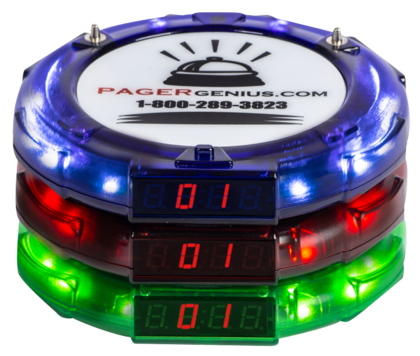
How Do Restaurant Pagers Work?
No one said running a restaurant was easy. While conjuring up tasty dishes and creating a
welcoming atmosphere might be tricky, you’ve also got to think about your customer service
– something which can make or break your restaurant as a business.
One commonly overlooked factor is managing customer wait times. If you’re fortunate
enough to have a packed dining area on weekends, you must consider how you’ll manage an overflowing waiting area full of eager, hungry, yet impatient guests. Trying to juggle multiple parties, names, and faces can be challenging – and without the right system, this can result in utter chaos and a loss of business.
Enter restaurant pagers. You may have come across these before – but do you know how they work?
In this post, we’re going to settle this once and for all, laying down how restaurant pagers
work and outlining their benefits. Let’s jump right in!
Table of content

What is a Restaurant Pager?
A restaurant pager is a wireless communication device commonly used in the hospitality sector to manage the seating process. It enables hospitality staff to notify waiting customers when they are ready to be seated, so customers can move around as they please without being restricted to one specific area.
This helps enhance the overall dining experience, offering comfort and freedom while
reducing congestion in a small waiting area.
You’ll typically come across components such as pager units, small devices given to
consumers when they arrive at the restaurant, and a transmitter, the central device operated by the staff to communicate signals to the pagers when tables are ready.
There are five basic pager types: the Beeper, VoiceTone, Numeric, Alphanumeric, and Two-
Way. They all serve different functions in the notification type but adopt the same goal of
alerting the user. Most restaurants use the beeper type. These are the ones that buzz in your hand to let you know your table is ready.

How Does a Restaurant Pager Work?
Typically, we get handed this small little box that gives us the freedom to wander about while we wait for our table. But how does this technology work? In essence, this tiny box is
actually just a pager. Let’s take a look at this in closer detail.
1. Pager assignment
When a customer arrives at the restaurant and waits for a table, staff can hand them a unique
pager. By definition, a pager is a very simple radio that listens to one station all the time. The radio transmitter broadcasts signals over a very specific frequency so the pager can pick it up.
All the pagers for the specific network are tuned into the same frequency broadcast from the transmitter.
Each pager has its own identification sequence known as a CAP (Channel Access Protocol) code, and each listens for its individual and unique code.
2. Transmitter setup
The restaurant boasts a central transmitter programmed to send signals to the pagers. The area range can change based on this device, but restaurants typically like to keep the area small anyway so that customers can return to the front desk to claim their table relatively quickly from when they receive their alert.
3. Pager programming
A staff member programs the restaurant pager by submitting the pager number to the
transmitter system, thus associating the pager with a customer waiting for a table to become
free.
4. Customer waiting period
As the customer waits for a table, they can choose to be anywhere within the transmitter's range, whether they want to soak up the sun in outdoor seating, nip to the loo, or keep warm inside.
5. A table becomes available
Once a table becomes available, the staff sends a signal to the specific customer pager
number by utilizing the transmitter. To do this, the staff enters the pager number into the
transmitter and presses the call button. The transmitter sends a radio signal on a specific
frequency, which includes the unique pager identifier.
6. The pager is activated
When a unique pager hears its code, it alerts the user and, depending on the pager type, will let the user know additional information. It alerts the user by lighting up, vibrating, beeping, or using a combination of all three, which is usually hard to miss!
7. Reset
Once the customer receives the alert, they return to the central area to be seated, returning the pager in the process. The staff then resets the pager so it can be assigned to a new waiting customer.
How Restaurant Pagers Work: Range Extenders
There are additional features and considerations to keep in mind about how restaurant pagers work, such as range extenders.
Range extenders can be used in bigger restaurants, enabling a larger area to be covered by the pager system. Furthermore, this is also handy for restaurants with outdoor waiting areas.
Challenges of Working Without a Restaurant Pager System
Now that you know your way around how our restaurant pagers work, you’ll be able to see
how they help restaurant owners navigate challenges. Without a restaurant pager system in place, your business may suffer from:
Overcrowded areas
Without a clear system to assist waiting guests, your waiting area may become crowded and uncomfortable for guests. Higher noise levels in crowded spaces may also make it tricky to call out the names of those who can be seated.
Delays
Staff who can only rely on verbal communication may face the issue of delays and mistakes in seating guests quickly. This inefficiency may lead to longer wait times and reduced table turnover rates.
Staff stress
Attempting to manage a long wait-list without relying on an efficient system can get the better of anyone, resulting in human error, decreased morale, and high stress. Be careful not to lose employees this way!
Customer frustration
Nobody wants to wait long for a table at a restaurant – even loyal customers. Testing your guests’ patience is never a good idea and could trigger negative reviews and profit loss as they decide to eat elsewhere.

Are all Restaurant Pagers the Same?
While you may first think that all restaurant pagers are the same because they function
similarly, think again! When buying a restaurant pager, you need to watch out for quality. While some pager batteries fail in just a few short hours, such as cheap models, others are superior. Our restaurant pager benefits include:
Durable
Restaurant pagers at Pager Genius are developed to be durable, ensuring they can withstand frequent handling from customer to customer.
One-time purchase
Wireless restaurant pagers are a one-time purchase. You only need to buy as many pagers as you need, and the fees stop there – after all, there are no required monthly fees to worry about when it comes to relying on a Wi-Fi connection.
Noticeable
With 19 flashing LEDs and a powerful vibration system that can be detected from a mile
away, customers will find it hard to miss a restaurant pager signal, unlike phone alerts. Pager Genius pagers even give customers a loud audio button option, which can be valuable in crowded, noisy settings.
Easy-to-use
Furthermore, our restaurant pagers have a friendly user interface. After looking above at how restaurant pagers work, I’m sure you can gather how straightforward the process is. The
process can even be completed if customers and staff members speak different languages, as all communication comes through the pager signal alert.
Strong battery life
At Pager Genius, we craft our restaurant pagers carefully to ensure they stay ahead of the competition, which is one of the many reasons why we offer impressive pager battery life. Our restaurant pagers can stay active for up to 72 hours on a full charge, which is handy for restaurants that run from early morning to late at night.
Our pagers usually run on rechargeable batteries, hence the fact that you will usually see them stacked up in a tall pile. This is because they all charge together through the contact of the metal of the connective screws at the corners. They charge through conductive metal electricity and form a charging chain. The rechargeable nature of the transmitters also ensures that you can reuse your pagers time and time again, saving you money in the long run!
Concluding on Restaurant Pagers
So, there you have it! The next time you wait for a table at a restaurant and patiently (or not
so patiently) stare at the pager in your hand, think about how much work goes into you
knowing that your table is ready for you. You might just have a whole new appreciation for
the technology that gives you the freedom to walk around while you wait!
Restaurant pagers are revolutionizing how hospitality businesses work, constantly evolving to
improve customer service. Implementing a restaurant pager system into your company could be the key factor that keeps your customers coming back for more.
Have a question about how restaurant pagers work? Please don’t hesitate to reach out to us
today. A member of our team will always be delighted to assist you and address any of your questions or concerns.
Additionally, for more insights from our pager system experts, be sure to check out our blogs
from around the industry.


